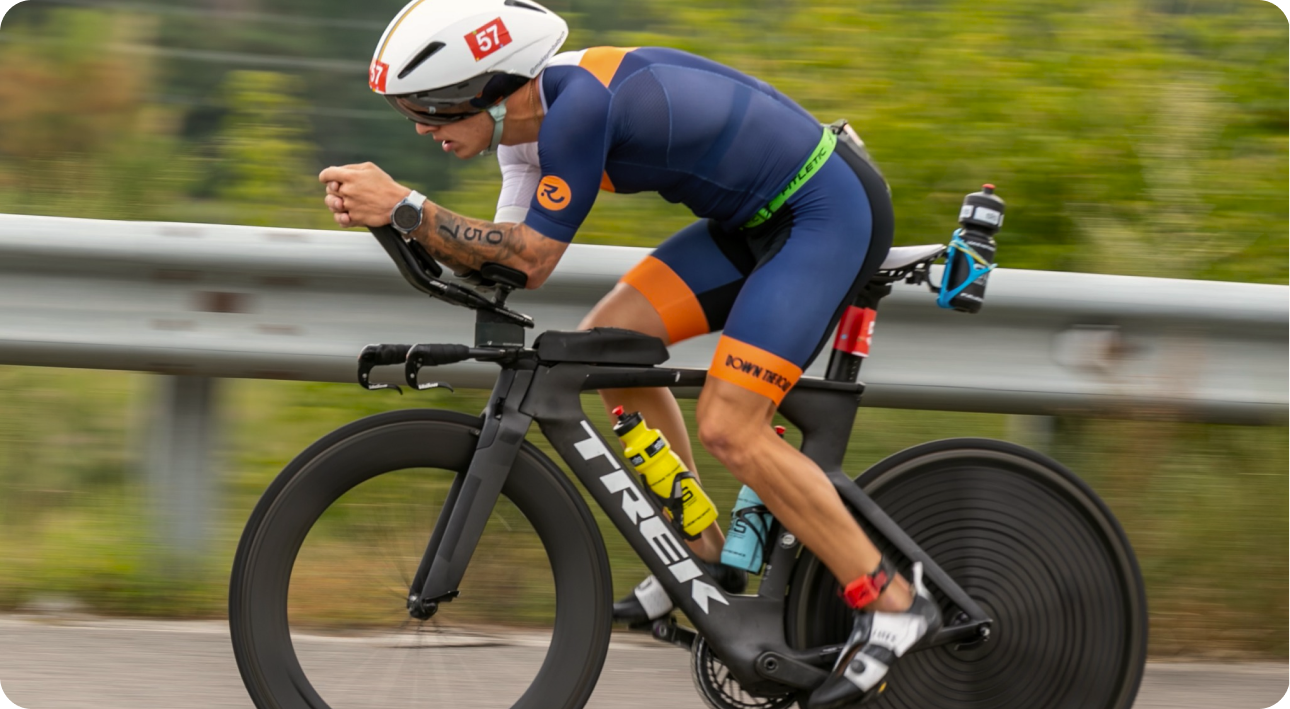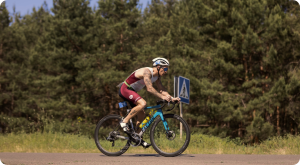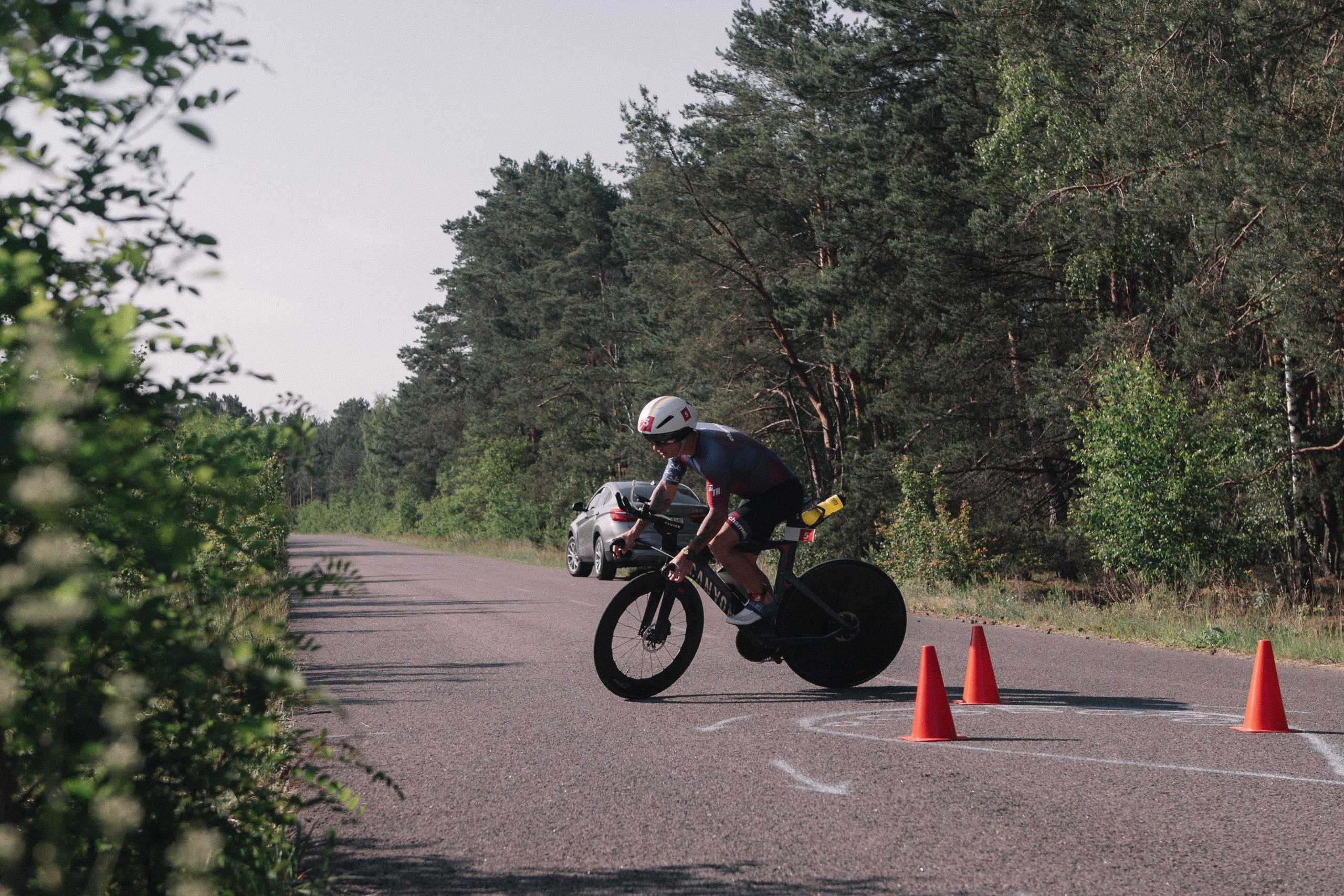Having a high aerobic capacity means that your body is able to deliver more oxygen to your muscles, which, in turn, can help you improve your endurance performance during both training and triathlon races. Here, we will go through what aerobic capacity is, why it matters, and how to measure it. We will also focus on some of the ways you can improve your aerobic endurance training and explore the common triathlete mistakes to avoid.
What is Aerobic Capacity?
Aerobic capacity is the maximum amount of oxygen your body can take in, transport, and utilize during intense or prolonged physical exercise. It reflects how efficiently your cardiovascular and respiratory systems deliver oxygen to your muscles, and how well your muscles use that oxygen to produce the energy needed for sustained activity.
This capacity is often measured as VO2 max (maximal oxygen uptake), which quantifies the highest volume of oxygen (in milliliters) your body can consume per kilogram of body weight per minute during maximal effort exercise. VO2 max is considered the gold standard indicator of aerobic capacity and overall cardiorespiratory fitness.

Why is Aerobic Capacity Important for Endurance Athletes?
Aerobic capacity is crucial for endurance athletes because it determines how long and how intensely you can perform aerobic activities such as running, swimming, cycling, or walking. A higher aerobic capacity enables better endurance and performance, while a lower capacity can limit exercise tolerance and increase fatigue.
Physiologically, aerobic capacity involves the lungs absorbing oxygen, the heart pumping oxygen-rich blood to muscles, and muscle cells using oxygen to convert glucose into ATP (energy) for muscle contraction. It depends on the functional capacity of the cardiovascular, respiratory, and muscular systems.
Multiple factors influence aerobic fitness. These include age, gender, genetics, body composition, muscle mass, and fitness level. Still, aerobic endurance is not constant, and it can be improved through regular aerobic exercise, especially high-intensity interval training (HIIT) and endurance training.
How to Measure Aerobic Capacity?
Aerobic capacity is most accurately measured by assessing VO2 max (maximal oxygen uptake), which quantifies the maximum amount of oxygen your body can consume during intense exercise.
The gold standard for measuring aerobic capacity is a maximal graded exercise test performed in a laboratory setting using equipment that measures respiratory gas exchange (oxygen and carbon dioxide) while the subject exercises to exhaustion, typically on a treadmill or cycle ergometer.
During the test, oxygen consumption (VO2) increases with exercise intensity until it plateaus despite further increases in workload, indicating VO2 max. This test also monitors heart rate, breathing volume, and respiratory exchange ratio to confirm maximal effort.
The test usually starts with a warm-up, followed by incremental increases in intensity every few minutes until the participant reaches volitional fatigue.
VO2 max reflects how efficiently the cardiovascular and respiratory systems deliver oxygen to muscles and how well muscles use it to produce energy.
Because maximal tests require expensive equipment and can be physically demanding, especially for some populations, submaximal tests or field tests are often used to estimate aerobic capacity.
Examples include:
- The Åstrand-Rhyming Cycle Ergometer Test predicts VO2 max based on heart rate response to a fixed workload.
- The Shuttle Run Test (beep test) estimates aerobic fitness based on running speed and endurance.
- The Rockport Walking Test uses walking time and heart rate to estimate VO2 max.
- The Brigham Young University Jog Test estimates the VO2 max from jogging time and heart rate.
Some formulas estimate VO2 max using heart rate metrics without exercise, such as:
VO2 max=15.3×(max heart rate/resting heart rate)
These formulas provide rough estimates but are less accurate than exercise-based tests.
Additional Measures Related to Aerobic Capacity
- Anaerobic Threshold (AT) or Lactate Threshold can be assessed during exercise testing to understand the maximum sustainable effort level. Here, we talk more about FTP testing for triathletes.
- Ventilatory threshold, identified by changes in breathing patterns during exercise, is another indirect measure linked to aerobic endurance.

How to Improve Your Aerobic Capacity
Aerobic capacity can be significantly improved with the right training strategies. Here are the most effective, evidence-based methods and endurance exercise examples:
High-Intensity Interval Training (HIIT)
HIIT involves alternating short bursts of intense activity with periods of lower-intensity recovery.
Research shows that HIIT is one of the most effective ways to increase aerobic capacity and VO2 max, especially when performed at or above your lactate threshold (about 80% of your max heart rate).
Example: 30 seconds of sprinting or intense cycling training followed by 1–4 minutes of easy recovery, repeated for 15–20 minutes.
Low-Intensity Steady-State (LISS) or Long Slow Distance (LSD) Training
LISS involves maintaining a moderate, steady effort (like brisk walking, jogging, or cycling) for an extended period.
It is a lower-stress way to build aerobic endurance and can be performed frequently, almost daily, for many people.
Aim for sessions lasting 20–60 minutes, gradually increasing duration as your fitness improves.
Cross-Training
Mixing different aerobic activities (running, cycling, swimming, strength training, rowing, dance classes) challenges your body in new ways and helps prevent overuse injuries.
You can alternate activities on different days or combine several in a single session.
Structured and Periodized Training Plans
Your triathlon training plan should combine both HIIT and LISS in your weekly routine for optimal improvement.
Periodization — structuring your training into phases (base, build, peak, recovery) — is key for long-term progress and avoiding burnout.
Beginners should start with shorter, lower-intensity sessions and gradually increase intensity and duration.
Practical Examples of Aerobic Workouts
- Walking or jogging
Start with 10–15 minutes and increase over time. Add intervals for more challenge.
- Cycling
Both steady rides and interval sprints are effective. Use a stationary bike or ride outdoors.
- Swimming
Offers a full-body, low-impact aerobic workout. Vary strokes and intensities.
- Group classes or dance
Fun, social ways to boost aerobic capacity (e.g., Zumba, boot camps).
- Circuit training
Combine resistance and aerobic exercises for variety and efficiency.
General Guidelines for Aerobic Endurance Training
Train at least 3–5 days per week, aiming for a minimum of 150 minutes of moderate-intensity aerobic activity weekly.
Gradually increase frequency, intensity, and duration to continue challenging your cardiovascular system.
Listen to your body and allow for adequate recovery, especially after high-intensity sessions, to avoid overtraining.
Additional Tips
Assess your current fitness level before starting and set realistic, progressive goals.
Choose activities you enjoy to stay consistent and motivated.
If you have any health conditions, consult a healthcare provider before beginning a new exercise program.
Combining these methods — HIIT, LISS, cross-training, and structured progression — allows you to effectively and safely improve your aerobic capacity, leading to better endurance, cardiovascular health, and overall fitness.
Common Mistakes to Avoid During Aerobic Training
Aerobic exercise might seem straightforward, but it’s one of the most powerful tools you have to boost endurance, protect your heart, and sharpen your mind — if you do it right.
Ruining the progress is much easier than it might seem. For example, athletes’ most common mistake is ignoring proper recovery.
According to this study on the relationship between aerobic fitness and recovery from high-intensity intermittent exercise, aerobic fitness plays a key role in enhancing recovery as it boosts the oxidative response, supports faster phosphocreatine regeneration, and improves lactate clearance. This helps the body recover more efficiently between bouts of intense exercise.
1. Skipping warm-ups and cool-downs
Not warming up properly increases injury risk and reduces workout effectiveness. Always spend 5–10 minutes on light cardio and dynamic stretches for cyclists before starting your main session.
2. Poor form
Incorrect technique not only limits results but also raises the risk of injury. Focus on proper movement patterns, and seek guidance if unsure about exercise form.
3. Overtraining and neglecting recovery
Training too often or too intensely without enough rest can lead to fatigue, injury, and burnout. Schedule regular rest days and listen to your body’s signals for recovery.
4. Not progressing workouts
Sticking to the same intensity or duration leads to plateaus. Gradually increase workout intensity, duration, or frequency to continue improving aerobic capacity.
5. Not setting clear goals
Training without specific, measurable goals can lead to a lack of athlete motivation and direction. Set clear, achievable objectives to guide your progress.
6. Doing too much or too little cardio
Excessive anaerobic exercises can lead to muscle loss and overtraining, while too little reduces aerobic gains. Find a balanced approach and consider including HIIT workouts for optimal results.
7. Poor nutrition and hydration
Not fueling or hydrating properly before, during, and after physical activity can cause fatigue and hinder performance. Maintain a balanced diet and stay hydrated. Here is more on nutrition and hydration for triathletes.
Final Thoughts
Aerobic fitness improves cardiovascular function, supports better metabolic health (learn more about metabolic testing for triathletes), and is linked to lower risks of conditions like heart disease, type 2 diabetes, and hypertension. It also directly enhances endurance performance.
The combination of aerobic and resistance training is often recommended for balanced fitness. It supports cardiovascular health and muscle strength, which are crucial for performance and longevity.
Consistency is key to improvement, and variety/progression prevent your body from adapting too easily, keeping the stimulus fresh and avoiding plateaus.
Remember to listen to your body, stay hydrated, and fuel your body with a balanced diet to support optimal endurance performance and overall health.
If you are looking for an ultimate training program to improve aerobic capacity, feel free to contact me or explore our coaching services.





